WW1 British Seaplane Carriers
 United Kingdom (1914-21) 17 ships
United Kingdom (1914-21) 17 ships
WW1/WW2 RN Aircraft Carriers:
ww1 seaplane carriers | Ark royal (1914) | Campania | Furious | Argus | Hermes | Eagle | Courageous class | Ark Royal (1936) | Illustrious class | Implacable class | Colossus class | Majestic class | Centaur class | Unicorn | Audacity | Archer | Avenger class | Attacker class | HMS Activity | HMS Pretoria Castle | Ameer class | Merchant Aircraft Carriers | Vindex classPioneer in naval air warfare
You would be surprised that on paper, in 1918, the Royal Navy had more “aircraft carriers” than in 1939. Of course, this is playing with words, as most were in reality mixed airplanes/seaplane carriers and not pure aircraft carriers. They had both platforms to operate land-based planes and cranes for operating seaplanes. A seaplane is still an aircraft.
In that register, the Royal Navy was one of the first nations to introduce dedicated aircraft carriers in operations while other tested it. She also became the most rprolific use of seaplane carriers, and “mixed” carriers, also operating land-based planes. The French had the old torpedo-boat mother cruiser Foudre converted in 1911, the USA made various tests (Eugen Ely and others) and Japan operated the converted cargo Wakamiya with Farman planes over the German Colony of Tsing Tao in 1914. Italy on her side operated the Europa in 1918. On the British side, the first of such ships was HMS Ben-My-Chree. She was followed by HMS Vindex, Nairana, Manxman, Anne, Raven II, Pegasus, Campania, Riviera, Engadine, or Empress converted from ferries most of the time, and the dedicated HMS Ark Royal, but also larger ships such as the Campania and Argus.

IJN Wakamiya, first seaplane carrier to launch attacks in a siege, Tsing Tao Sept. 1914
Seaplane Carriers versus Aircraft carriers
The first properly named “aircraft carriers” has been the HMS Furious (world’s first operational, true aircraft carrier), Argus, Vindictive, Eagle, all converted, and HMS Hermes, first purpose-built (of the Royal Navy). Japan had the Hosho. The latter are familiar names indeed as they were used during WW2 as well. To this, we can add the two later converted light battlecruisers of the Courageous class. Altogether, these ships provided air reconnaissance and support in nearly all major naval operations, in addition to the coastal naval air arm, and numerous balloons used for maritime reconnaissance during the great war. Of course, this single article is way too short to enter in detail in the career of all these ships, which will be treated all with their own post in the next months and years.
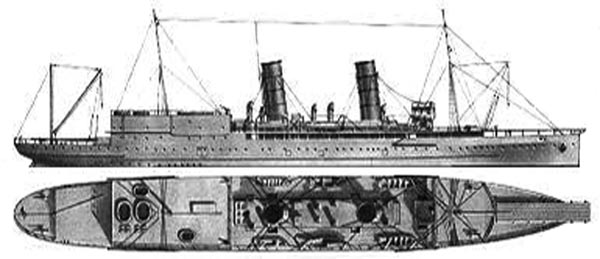
2 views of the Ben My Chree, first British seaplane carrier
British seaplane carriers
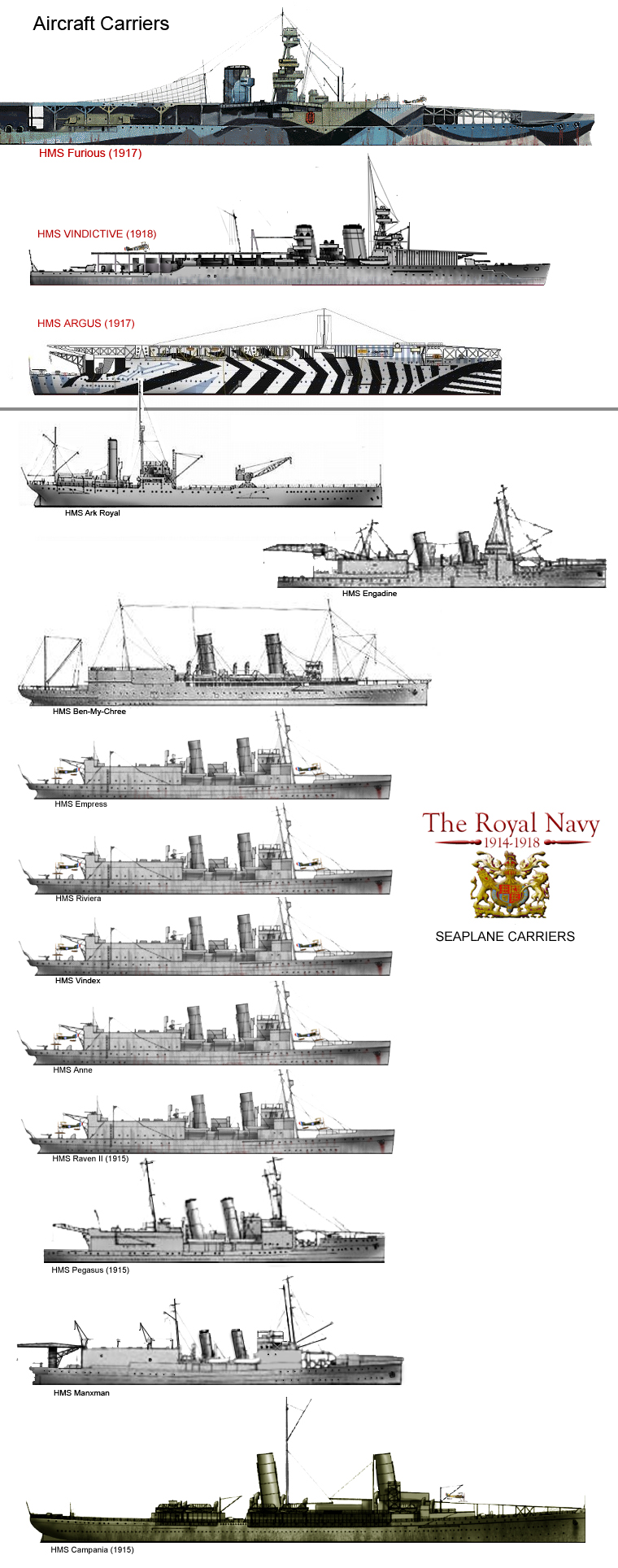
The genre appeared earlier than aircraft carriers for obvious reasons: It was much easier to lift in and out a seaplane at sea with a simple crane, and for it to operate from the sea than launching and recovering wheeled aircraft from a platform, how big or small it was. Though, with rapid progress in aviation during the war, it was not long to recognize that a wheeled aircraft created less drag than float-equipped seaplanes, and therefore had quite an increase in performances and range. In fact, the small size and weight of fighters allowed simple platforms to be raised above the main superfiring guns of many battleships in 1918, the only problem being recovery was impossible. This one-ticket solution was reused in WW2 with the catapult-equipped MAC ships.

Ben-My-Chree, model kit more detailed profile
How British seaplane carriers operated
A British seaplane carrier was in general a ferry, about 1200-2500 GRT, requisitioned in August 1914 and at first carrying two seaplanes, placed on the deck, under canvas fore and aft and hoisted to the sea by booms and cranes. They were deployed wherever artillery spotting and reconnaissance could be performed from the coast over an hostile territory. But quite quickly they proved versatile, reflecting the general usefulness of aviation and explosion of the aircraft industry during the great war. Until 1918, their mission panels grew accordingly to their performances. It was found however during these early missions that a simple tarpaulin was not sufficient to prevent corrosion with salt water, damaging the engines.
In early 1915 most of these requisitioned and hastily converted ships were taken in hands, generally at Cunard yards, for a simple conversion as proper military ships: Typically they were given an aft fixed hangar, large enough to carry two Short floatplanes, with folded wings, and a Sopwith or any other light aircraft/fighter on the forward take-off deck. These were powerful and light enough to take off from quite short runways, helped often by the use of wheels blockers, manually retired when the engine was at high regime.
This was found so useful that in 1918, most British battleships gained platforms on their upper turrets, sometimes fore and aft. Both types, the long-range, bomber/torpedo carrier Short and the nimble fighter complemented well. The second could protect the first during their mission for example. In addition to these features, the ships received a proper armament, typically four 12-pdr/12 cwt and two QF 3-Pdr AA guns.
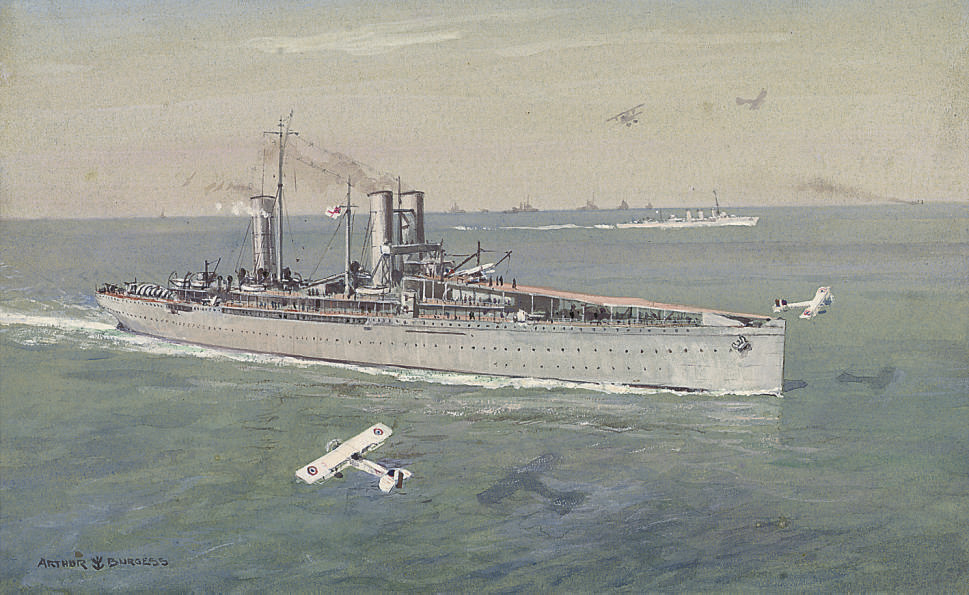
HMS Campania, painting (sold on Amazon)
As the war intensified as well as the diversification of theaters of operation, the slowest of these seaplane/mixed carriers were either versed to the Merchant Red ensign fleet (operating with a civilian crew), carrying planes, or provided support for operations in the Mediterranean, Adriatic, Aegean sea, red sea, or Indian ocean. The fastest operated with the Grand Fleet, such as the Campania and Argus. Outside raids over German airships naval bases such as Cuxhaven, in 1918, more powerful planes could deliver bombs and torpedoes to any objective. The HMS Campania for example (1891) was fast enough and large enough to constitute a “quasi-aircraft carrier”. As an auxiliary cruiser fitted with a large platform for fixed landing gear aircraft to takeoff.
This second career was remarkable enough as she was to be broken up as Obsolete by October 1914, sold to T W Ward for scrapping. After thinking of making her an auxiliary cruiser she was refitted and recommissioned on 17th April 1915, launching in August a Sopwith Schneider. She operated with the Grand Fleet seven times due to her great speed but had trouble operating seaplanes due to the conditions in the north sea. HMS Argus (1918) had much more success in this area due to her large and generous, unobstructed deck. In 1918, she operated ten planes, including seven Short Torpedo Bombers and 3-4 fighters, resembling the most to a naval air squadron. Her success was such, the admiralty ordered the design of the tailor-made Fairey Campania to operate on board. This was the world’s first carrier-borne serial military aircraft.

HMS Hibernia operating a Short S.28 from a forward test ramp
About floaplanes on these British seaplane carriers
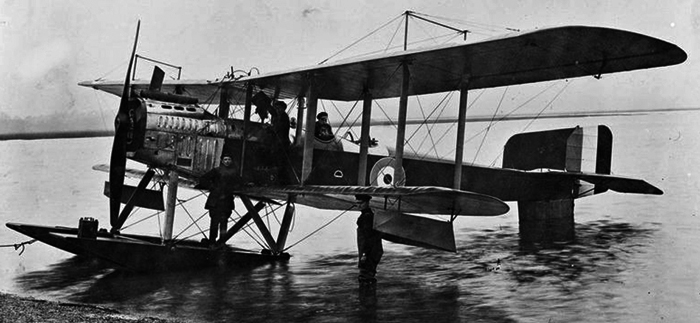
Fairey F.22 Campania, the main carrier torpedo floatplane
The floatplane was a relatively recent invention, in 1910 by Henri Fabre, which named it the hydravion, followed by Denhault and Curtiss. This, two years later, triggered the conversion of the Foudre, to test these new “eyes of the fleet”. Floatplanes remained the staple of naval reconnaissance until the generalization of the radar during WW2. From there, three terms have been used to qualify the numerous types of floating planes, which took a relatively different meaning in time.
“Seaplanes” and “floatplane” were applied to rather small to medium, often converted aircraft, while with size increasing the term “flying boat” was preferred. In the interwar, flying boats, in addition, to be used to create the first intercontinental airlines, were generally accessible only at sea. They were not amphibious, while rather smaller “seaplane/floatplane” models were (floats and wheels).
Also, the latter were often developed from regular mass-produced models equipped with floats, replacing the wheels carriage, while flying boats had a central fuselage shaped like a boat and were better suited to operate from the sea, and operated from coastal bases while floatplanes and seaplanes operated from ships.
The British on their side developed during the war an impressive array of flying boats and seaplanes. One of the early proponents of the type in the Royal Navy was John Cyril Porte, a retired Royal Navy Lieutenant, working closely with American pioneer Glenn Curtiss. Their work was interrupted by the war (see later). Meanwhile, British boat-building J. Samuel White of Cowes (Isle of Wight) designed and built the first British seaplane. Also, S. E. Saunders (A boatyard from East Cowes) and Sopwith Aviation collaborated to create the “Bat Boat”, first British amphibious seaplane, holder of numerous records and awarded the Mortimer Singer Prize.
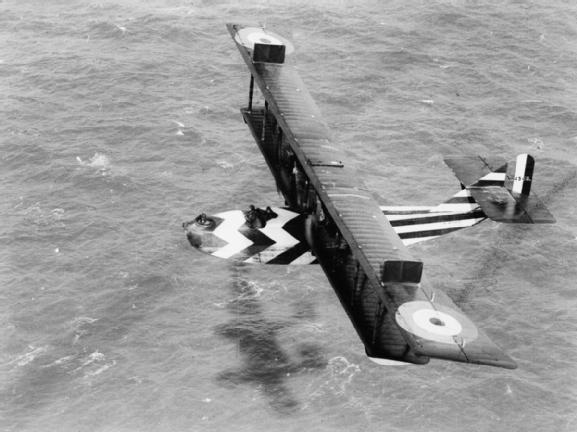
A Felixtowe F2A long range flying boat. These bring a considerable improvement in ASW reconnaissance and warfare at the end of WW1.
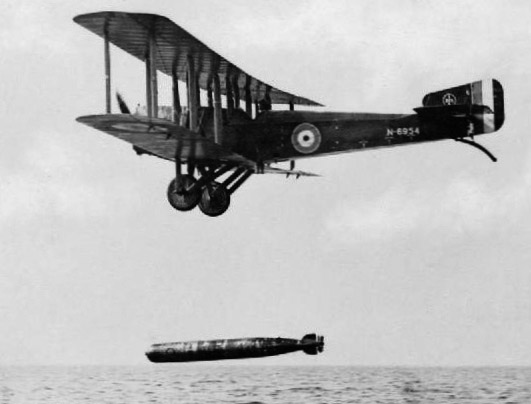
The RNAS torpedo-carrier Sopwith Cuckoo was tailored to operate from aircraft carriers, such as HMS Furious.
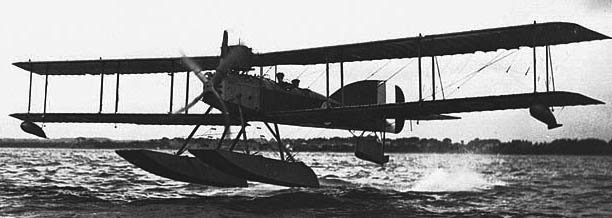
The widely used Short 184 (over 900 built)
Short was by far, the main seaplane provider of the RNAS, providing more than 950 Short Admiralty Type 184 and many other models. Blackburn made in small quantities the GP (General Purpose) and RT1 Kangaroo. Fairey became the second major provider of the RNAS with the Fairey Campania, Fairey 9 and Fairey III seaplanes. Felixtowe became the leading flying boat provider of the RNAS, specializing in large, coastal patrol planes. Sopwith also started with the RNAS, creating the Special torpedo seaplane Type C, derived from the prewar Bar-Boats. The Sopwith Baby was also a widely used carrier seaplane, the Type 860 became a heavy attack seaplane, and the Sopwith Cuckoo, the world’s first aircraft carrier-based torpedo type in 1918.
British Seaplane Carriers in detail
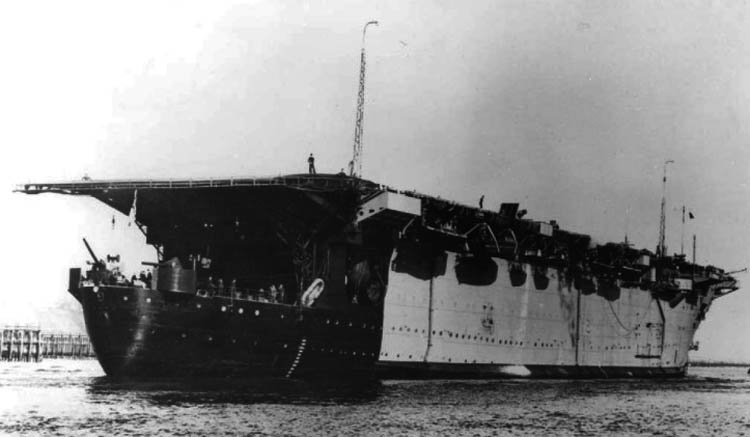
One of the first converted seaplane carriers was Ben-My-Chree in 1915. A Manx 1908 steamer, she was transformed in 1915, operating 4 Short S184 seaplanes in the Mediterranean, sunk in 1917 by the Turkish coastal artillery. She was followed by the Vindex, a fast steamer of 1907, converted in 1915, as well as the HMS Manxman, of the same ilk, both equipped with a flight deck and landing platform, and thus capable of implementing a wide variety aircraft. They also had “catapults” before the letter. A little later, in 1917, HMS Nairana came along. But they were also the Ark Royal, Empress, Riviera, Engadine, Anne, Raven II, Pegasus, often former coal and grain carriers, with large holds ideal to store planes. Two more will be converted in 1919 on the Caspian Sea to support the “whites” during the Russian Civil War.
The most famous of these converted British seaplane carriers was undoubtedly the old SS Campania (1893) of the Cunard, a luxury liner of the Atlantic line, Blue Ribbon winner, which was endowed with a vast flight deck and lost in a collision in 1918. The other was HMS Argus, a less glamorous conversion of the Italian liner Conte Rosso, then under construction in Beardmore. She was not accepted until September 1918, because she was the navy’s first true aircraft carrier with a complete deck. She had to complete the HMS Furious by training pilots.
HMS Ben-My-Chree (1915)
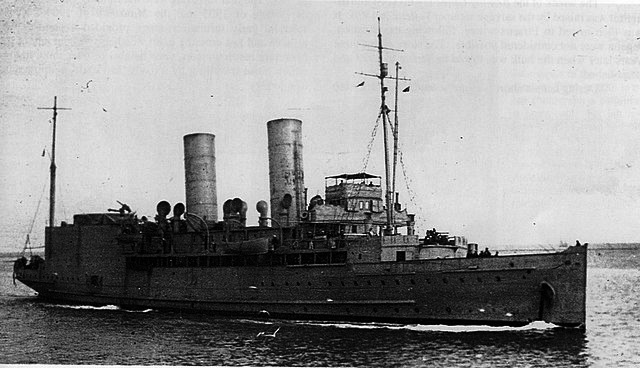
Built by Vickers-Barrow in 1907 and named in Manx (“woman of my dreams”), she was was a packet steamer for the Isle of Man Steam Packet Company, between the English coast and the Isle of Man. Ben-my-Chree has been awarded three crossing speed records on the line Liverpool – Douglas under three hours. However, at the beginning of 1915, she was mobilized for conversion into a seaplane carrier at Cammell Laird (Birkenhead) on January, 2. Her aft superstructure was replaced by a hangar aft of her rear funnel, to house four to six seaplanes. Derricks were installed fore and aft to left them. Also to help these take off in rough sea, a dismountable 18 m flying-off platform was installed forward of the superstructure with a trolley and rails for guidance and propulsion. This was not a true catapult, still.
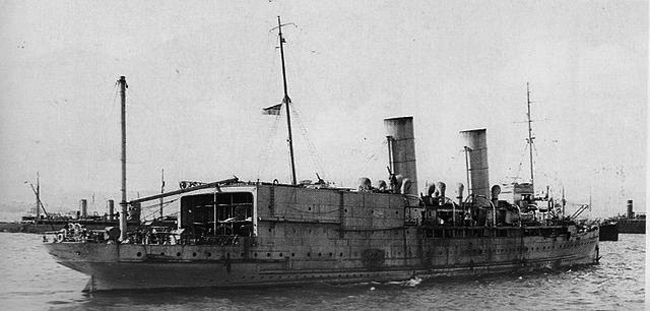
Displacement rose to 3,888 long tons (3,950 t) in military service for a length of 387 feet (118.0 m) long overall, 16 feet (4.9 m) draft. She kept her turbines generating 14,500 shaft horsepower (10,800 kW) providing a top speed of 24.5 knots (45.4 km/h; 28.2 mph) and carried 502 long tons of coal. Her military crew was much larger, with 250 officers and enlisted men, including pilots. She was armed with four QF 12 pounder 18 cwt naval guns plus two QF 3-pounder Vickers AA guns and carried 130 rounds and 64 rounds for each guns types respectively. In May 1916, she received an additional 12-pounder AA gun, plus a single 3-pdr and a 2-pdr “pom-pom” on army carriages.
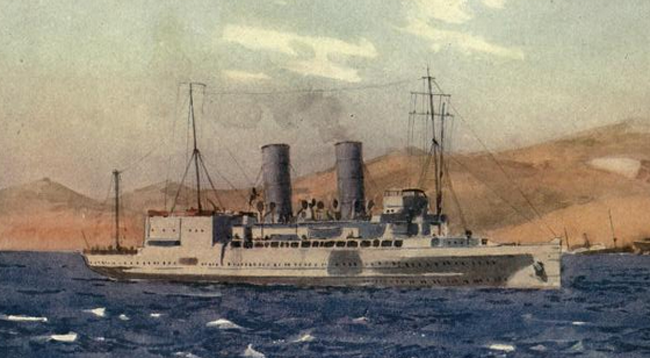
She has been scrambled for a possible attack on the German coast, that never materialized in May on Norddrech because of the fog. Instead in June, she was transferred to the Dardanelles as the Gallipoli Campaign rages on. She operated four Short 184, and one of these was modified to make the first ship-launched aerial torpedo attack in August. After Gallipoli evacuation, HMS Ben-my-Chree became flagship of the East Indies and Egypt Seaplane Squadron. Their missions were reconnaissance and attack Turkish installation and troops on coastal areas. Ben-My-Chree was eventually sunk by mobile Turkish artillery as she was anchored at Kastellorizo in early 1917. However, everyone survived and only five members of the crew were injured. She was salvaged in 1920, towed and sent to local brokers in 1923.
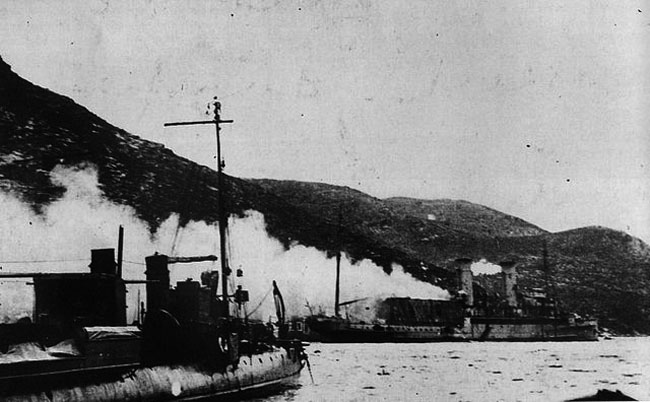
HMS Vindex (1915)
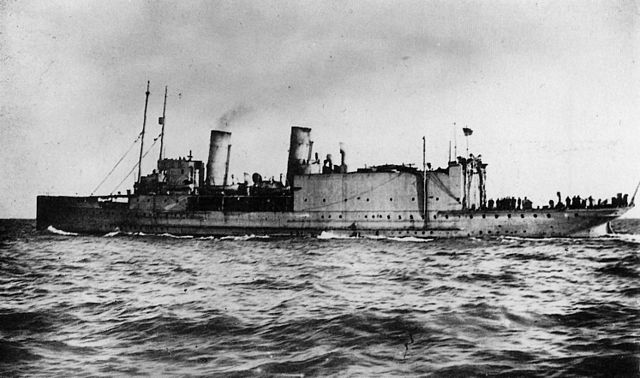
HMS Vindex in 1915
HMS Vindex was born in 1905 at Armstrong Whitworth (Newcastle upon Tyne) as SS Viking, fast passenger ferry on the Isle of Man line. Requisitioned on 26 March 1915 she was converted as a seaplane carrier, purchased in November under the new name of HMS Vindex (There was already a destroyer named HMS Viking). She was 361 feet 6 inches (110.2 m) long for 42 feet (12.8 m) and 13 feet 8 inches (4.2 m) draught, for a 2,950 long tons (3,000 t) displacement. She was propelled by three direct-drive steam turbines, coupled tow four VTE boilers giving a total of 11,000 shaft horsepower (8,200 kW). 475 long tons (483 t) were enough for 995 nautical miles (1,843 km; 1,145 mi) at 10 knots (19 km/h; 12 mph).
She was armed by four 3-in/50 (76 mm) 12-pounder 18 cwt guns (130 rounds each). The practical range was 9,300 yd (8,500 m), averaging 15 rpm, and a single QF 6 Pdr Hotchkiss AA gun for which (about 20 rpm, 10,000 ft (3,000 m) ceiling. Later two 4-inch (102 mm) anti-aircraft guns replaced it. There was a 64-foot-long (19.5 m) flying-off deck, forward to operate land-based, wheeled undercarriages planes. A massive hangar was built aft and two electric cranes fitted to handle her on-board aviation. Two dismantled single-seat aircraft were stored in the small forward hold, ready to operate in ten minutes from the platform and five floatplanes in the rear hangar. So she operated up to seven aircraft, including seaplanes but also the land-based Sopwith Schneider, Pup and 1½ Strutter. The crew comprised 218, including 76 aviation personnel, pilots and mechanics.
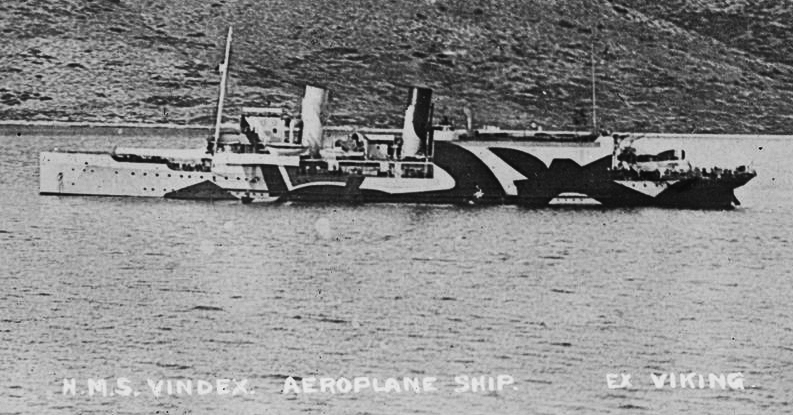
HMS Vindex, camouflaged in 1918
Vindex first served with Harwich Force from November 1915, North Sea until 1917. Tests were performed with Bristol Scout C launched when steaming ar 12 knots, from the flight deck. That was a first. In March the next year, HMS Vindex’s planes attacked a Zeppelin base at Tondern with Short Type 184 escorted by Sopwith Baby, all floatplanes. The attack was repeated on 4 May with HMS Engadine. However, the 65-pound (29.5 kg) bombs they carried were almost harmless, while the planes failed to take off. In August her Bristol Scouts attacked Zeppelin LZ17 with explosive Ranken darts, also a first. Transferred to the Mediterranean (Malta) in 1918, she served here until 1919. Sold back in February 1920 she was reverted to SS Viking, and requisitioned again in WW2 to serve as a troopship.

Author’s profile of the HMS Vindex
HMS Manxman (1915)

HMS Manxman was born SS Manxman in Vickers, Barrow yard, laid in 1903. She had three propellers and turbines (10,000 hp, 22 knots) for a tonnage of 2030 GRT and dimensions of 330 by 43 feet by 18 feet. She could carry up to 2,020 passengers and had a crew of 80.
She was converted at Chatham Dockyard, receiving two aircraft hangars and a flying-off deck forward. Commissioned as HMS Manxman by 17 April 1916 she would carry the Sopwith Baby, Sopwith Pup, Sopwith Camel and Short Type 184 during her career.
She served until October 1917 with the Grand and was transferred to the Eastern Mediterranean.Not as fast as the earlier Ben-my-Chree and Viking, she could not keep up indeed with Grand Fleet, as her conversion added too much displacement. This was clearly underlined by Admiral Sir David Beatty, in his own handwriting.
She however was the first ship in the Navy to make good use of the Sopwith Pup single-seat fighter in combat. The nimble and nervous aircraft could take off from a 20 feet long platform, in a 20-knot wind due to a favourable power-to-weight ratio. She used Flotation bags, which allowed her to “crash” in the water near the ship, and be hoisted up back onboard. In 1918 she was based on the coast of East Africa, from Zanzibar on 22 November, learning the hostilities were over. She sailed back to Plymouth at the same time as HMS Viking, was paid off in May 1919, and returned to the civilian market to serve for the Isle of Man Steam Packet Company (as SS Manxman) and in WW2, ferrying troops back from Dunkirk and Cherbourg and later as HMS Caduceus from 1941, refitted as a Radio Direction Finding Vessel.
HMS Empress (1915)
Launched in 1907, she was at first the SS Empress, owned by the South East and Chatham Railway, built at William Denny and Brothers Dumbarton. She was requisitioned by the Admiralty on 11 August 1914, and 14 days later commissioned as HMS Empress, at first carrying planes and equipments from the Eastchurch Squadron of the Royal Naval Air Service to Ostend.
When back she was sent to Chatham for reconstruction as a seaplane carrier, carrying three seaplanes: One was stored on the forward bridge, covered by a tarpaulin and launched from a flying-off platform and the two at the rear were stored in a canvas hangar and hoisted to the sea when used. She received two QF 2-pdr for self defence and operated the Fairey Hamble Baby, Short Admiralty Type 74, Short Type 184, Sopwith Schneider and Sopwith Baby floatplanes.
As this was found insufficient she was taken in hand in May-July 1915 and modified by Cunard, Liverpool, fitted with a permanent four-aircraft, hangar and received a better armament, four QF 12-pounder 12 cwt guns and two 3-pdr AA. Relatively slow she did not served with the Grand fleet but in January 1916 was operated by the East Indies and Egypt Seaplane Squadron, together with the Raven II, Anne, and Ben-my-Chree.
She operated against Turkish positions in southern Palestine, Sinai and later the Aegean coast of Bulgaria, and after a refit at Genoa, she was back at the Syrian and Palestinian coast, and then she was versed to ASW patrol from Port Said and later Gibraltar until the end of the war. After it in 1923 she was sold to a French company, collided with a British schooner in the channel and was scrapped in 1933.
HMS Riviera (1914)
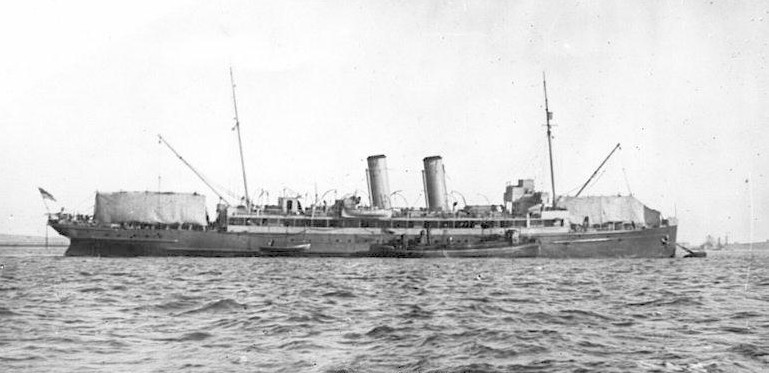
HMS Riviera in 1914, showing her canvas floatplane tents.
HMS Riviera was born SS Riviera, Owned by the South East and Chatham Railway in 1911 after entering service. Registered in London she has been built by William Denny and Brothers, Dumbarton from Scotland, launched on 1 April 1911. Requisitioned on 11 August 1914, she was commissioned on 6 September after modifications at Chatham Dockyard. She was given three canvas hangars. She was operating with the Harwich Force a participated in the Cuxhaven raid against German airships.
In March-April 1915 she was taken in hands for a true conversion at Cunard, receiving a hard aft hangar and gunnery, four 12-pounder 12 cwt guns and two QF 3-pounder anti-aircraft guns. Operating four seaplanes, Short Type 184, she operated on the river Ems and spotting missions for naval bombardments off the Belgian coast, before going to Malta by 1918. She was resold back home to the South Eastern and Chatham Railway in 1919 and converted back.
HMS Anne (1915)
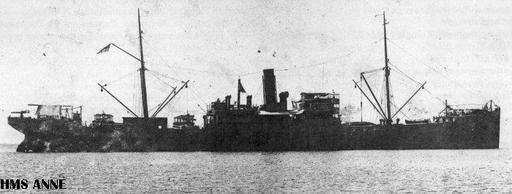
HMS Anne in 1914
This vessel was acquired in a unusual way, as the German SS Aenne Rickmers she was seize in August 1914 in Port Said near Alexandria. This 4,000 GRT liner was built by Bremerhaven in 1911, but slightly larger than most British seaplane carriers, she was limited by her slow speed, her single shaft and triple-expansion steam engine giving her 11 knots (20 km/h; 13 mph). At first she served with the Red Ensign of the British Merchant Marine, carrying goods and personal in the Mediterranean, before being taken in hands in early 1915 for a conversion as a seaplane carrier.
She at first received former French Nieuport VI.H floatplanes from the old cruiser Foudre, flying with British observers and French pilots. She participated in allied operations in Syria, Palestine and the Sinai Peninsula, and was torpedoed by the Turkish TB Demirhisar. She regularly bring support to various French warships, providing reconnaissance and artillery spotting.
From 1916, she joined the East Indies and Egypt Seaplane Squadron and served with three other seaplane carriers, and among other, she spotted an U-boat base at Makry. Her planes made 118 missions and two were lost. The squadron was later given to the French seaplane carrier Campinas and served afterwards as a plane carrier from Port Said. She was transferred later to the red sea, and served with the HMS Fox and Dufferin of the Royal Indian Marine (RIM) from Rabigh. She supported the Arab revolt as well in 1917. However from from 29 January 1918 she was converted back as a collier, under the Red Ensign. She was sold in 1922 to S.N. Vlassopoulos of Greece and to a Romanian company in 1939, then in 1942 Wallem & Co. and renamed Jagharat in 1954 (Panamean flag) and Moldova from 1955, scrapped in 1958.
HMS Raven II (1915)
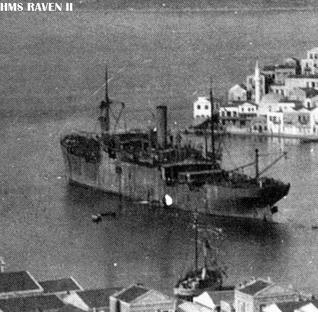
HMS Raven 2 in Port Said, probably 1914. Like Anne she never has been converted and simply carried aviation inside her holds.
In Port Said, the British authorities captured several German ships in August 1914. The SS Rabenfels, operated by Hansa was one of these. Built at Swan Hunter as a 4,706 GRT freighter, she was powered by a single quadruple vertical expansion steam engine, giving her 10 knots. She was recommissioned in the Royal Navy as Raven II, on 12 June 1915. She operated with the Red Ensign, with planes stored into the holds, with simple hatch covers over them. She operated Short Type 184, Sopwith Schneider, Sopwith Baby and Short Admiralty Type 827 floatplanes.
She was in missions together with the seaplane carrier HMS Anne, participating in artillery spotting and later passed onto the larger East Indies and Egypt Seaplane Squadron deployed over Palestine and Sinai in early 1916. She also fought in the Red Sea. She played a role during the great Arab revolt, hdropping supplies, attacking Turkish positions, or bringing armaments and supplies at Aqaba after it was taken. She also operated in the Aegean sea, and later the squadron helped Monitors to shell El Afule.
She also operated in the Adalia area and after bombed by a German plane, relieved by Anne and later sent to harass Turkish troops at Rabigh and Yenbo, cutting a bridge at Ceyhan River. She later teamed with the French cruiser Pothuau in search of a German blockade runner in the Indian Ocean, up to Colombo, and down to the Chagos and Maldives islands. She was later back at Port Said to participate in the Third Battle of Gaza. She was however paid off innovember-December 1917 and returned to the Red ensign to wotk as a collier. After the war, she was purchased by Japan as SS Ravenrock and served as SS Heiyei Maru No. 7, sunk in the Pacific during ww2 at an unknown date.
HMS Pegasus (1915)
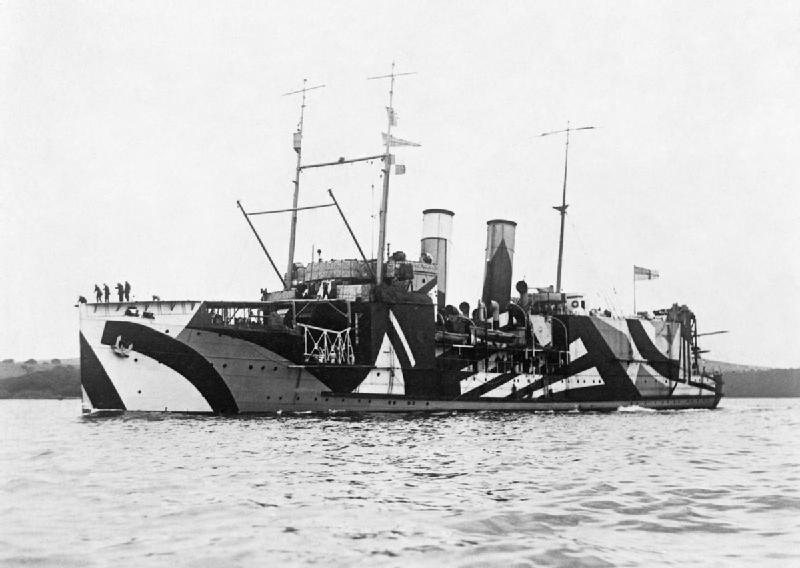
HMS Pegasus in a dazzle camouflage, 1918
This John Brown built Ferry for the Great Eastern Railway was named SS Stockholm. She was laid down in 1914, but construction was suspended, and restarted later. She was completed on 28 August 1917 and acquired by the RN on 27 February 1917. She was 332 feet 4 inches (101.3 m) long, 43 feet (13.1 m) wide, with 15 feet 9 inches (4.8 m) draught at deep load.
She displaced 3,315 long tons (3,368 t). Conversion into a seaplane carrier commenced immediately. She was recommissioned on 14 August 1917, armed with four 40-calibre, 3-inch (76 mm) 12-pounder 12 cwt, and operating four floatplanes, but later eight planes, four Short Type 184 torpedo bombers, four Beardmore W.B.III fighters. Later she received four Sopwith Camel 2F.1, one Type 184 and three Fairey Campania.
In her large holds she carried 1,300 imperial gallons (5,900 l; 1,600 US gal) of petrol for te aviation while were stored eight 18-inch (457 mm) torpedoes, 72 100-pound (45 kg), 108 65-pound (29 kg), and 68, later 84, 16-pound (7 kg) bombs. Like the other ships, she had a large aft hangar and a forward flying-off deck. Capable of 20 knots, she joined the Grand Fleet.
She supported the Battle Cruiser Force but missions were rare. She usually spent her time training pilots or ferrying aircraft to battleships operating flying-off platforms. She was more active during the Russian Civil War in 1919, supporting the “Whites”from Archangelsk. She was later sent in the Mediterranean Fleet in March 1920 after a short refit. From 1924 she became a new career as an aircraft tender stationed at Singapore. On 5 July 1925 she was back in Devonport, in reserved, but recommissioned in 1929 and discarded, sold in 1931 for scrap at Morecambe.
HMS Campania (1915)
This famous ship was a former, innovative transatlantic of 1891-93. She was built at Fairfield Shipbuilding and Engineering Co Ltd of Glasgow and was launched on 8th September 1892 but completed in 1894. Measuring 622.0′ x 65.2′ x 37.8′ for displacing 20,990 gross tons she entered service with the Cunard on her famous Transatlantic American line (Liverpool-NYC), earning the Blue Ribbond. It was retaken by her sister ship, the SS Lucania not long after and the record held until 1897. Both had a twin 5 cylinder vertical triple expansion engines generating 28,000 ihp. The SS Campania was the first Cunard liner fitted with the Marconi wireless telegraph.
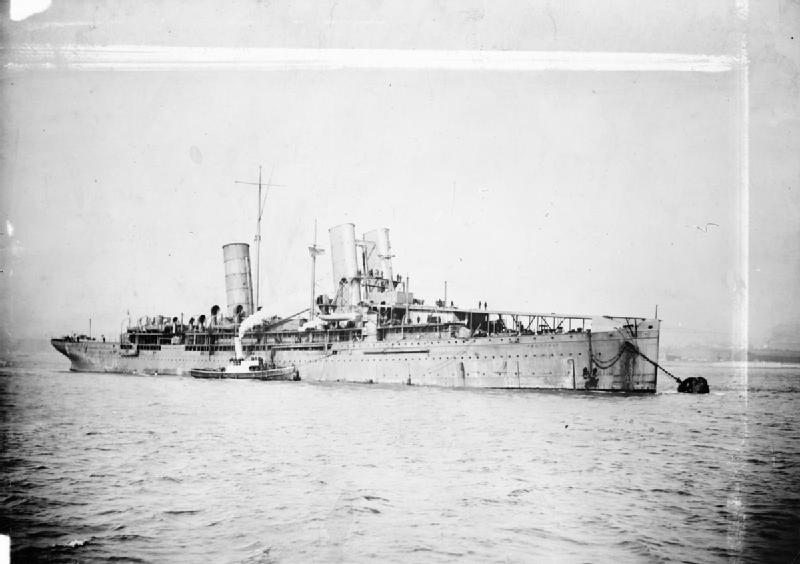
Fairey Campania in 1916
By October 1914 she was considered obsolete by her company and resold to brokers. She was saved by her immediate requisition by the RN in October 1914. She was to be used as an auxiliary cruiser at first, purchased for £32,500. The plans changed however towards the end of 1914 and she was converted as an aircraft carrier, with a 160-foot flying-off deck mounted in top of the forward superstructure.
Cranes were fitted either side to transfer seaplanes between the water and hold, which had the capacity for seven large seaplanes. The secondary the forward hold under the flight deck was large enough for four small seaplanes but there was a manoeuvre to lift a flight deck section to access them. Therefore manoeuvres were relatively long and necessitated a calm sea.
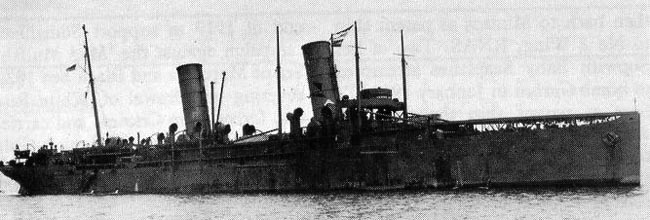
The HMS Campania in her first 1915 appearance, still with the relatively short flight deck and unchanged funnels.
HMS Campania was recommissioned on 17th April 1915. Her first flight was performed by a Sopwith Schneider in August. Mounted on a wheeled trolley, she was propelled in the wind while the ship was cruising at 17 knots; Despite of this the lightest and highest-powered RNAS model barely took off, showing the limits of the system. By October 1915 she started to operate with the Grand Fleet. In total she would perform a few missions, showing that taking off in rough seas with violent winds was detrimental for safety.
The captain requested modifications, which was granted in November 1915. She ship entered the Cammell Laird to see her flying-off deck lengthened and given a steeper slope for the planes to accelerate.
She was back in operations in April 1916, showing her forward funnel split in two to manage space in between to extend the flight deck up to 245 feets. A canvas windscreen was provided to unfold the plane’s wings before takeoff and an observation balloon and supporting gear was placed aft.

HMS Campania in 1916, showing her modifications.
By May 1916, the Campania operated with the Grand fleet a small squadron composed of seven Short Type 184 torpedo bombers and 3-4 fighters. The first flight was performed in June, using a wheeled trolley (no catapults yet). Success confirmed the soundness of the modifications. The admiralty then ordered the company Fairey to produced a tailored carrier aircraft, world’s first, called aptly the Fairey Campania. They replaced the Short models in 1917 and joined brand new Sopwith 1/12 Strutter scouts.

The Fairey Campania torpedo/bomber/scout, world’s first carrier-borne designed aircraft.
She departed Scapa Flow on 30th May 1916 the day of the Battle of Jutland, only to return as she lacked an escort: German submarines had been reported in the area. Later she participated in ASW patrols and searching for Zeppelins. However her worn out machinery was troublesome to the point of declaring her unfit for fleet duty. Later in 1917 she became a seaplane training vessels and balloon depot ship.

HMS Campania, camouflaged in 1918
By November 1918 the war was over and HMS Campania was moored in the Forth nearby HMS Glorious, HMS Royal Oak and HMS Royal Sovereign, off Burntisland, Fife. On the night of 4th November, Captain John J C Lindsay was in his cabin while Lieutenant Thomas Smart RNR was the Officer of the Middle Watch. It was a calm night, but around 03:00, a force 4-5 wind started to pull on the chains, and this evolved to a violent force 10 burst. This was enough to drag the Campania out of her position. The staff however failed to order the release of the secondary anchor, and at 03:35am, her flank met HMS Royal Oak’s bow on her port side at the dynamo compartment. Rapid flooding was limited by the use of watertight doors, but on the long run, failing to receive any assistance she sank by the stern, still deriving. It took five hours for her to finally sink upright near HMS Royal Sovereign, with no casualty on board as all had been evacuated.
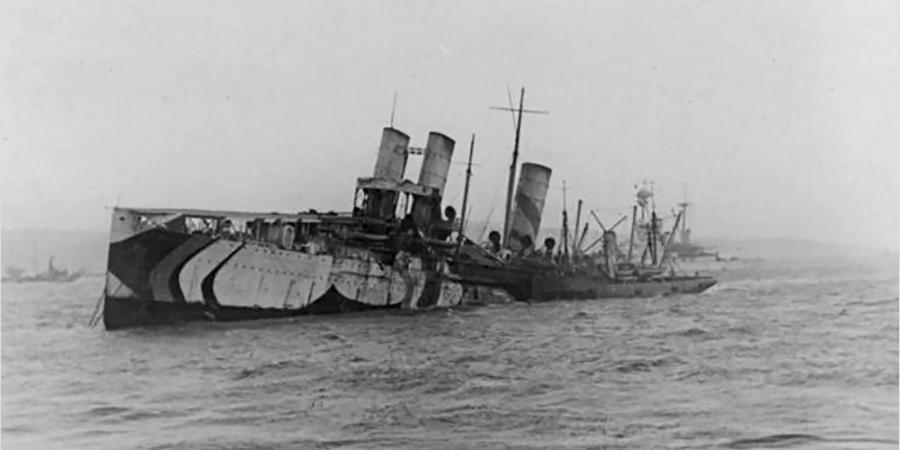
HMS Campania slowly sinking in the Firth of Forth on the early morning, 5 November. There will be a standalone post on her…
Read More
https://en.wikipedia.org/wiki/List_of_seaplane_carriers_of_the_Royal_Navy
http://www.navypedia.org/ships/uk/brit_aux_iav.htm
http://www.benjidog.co.uk/recollections/Captain%20Wiles.html
wikipedia.org – Seaplane
ww1-planes.com

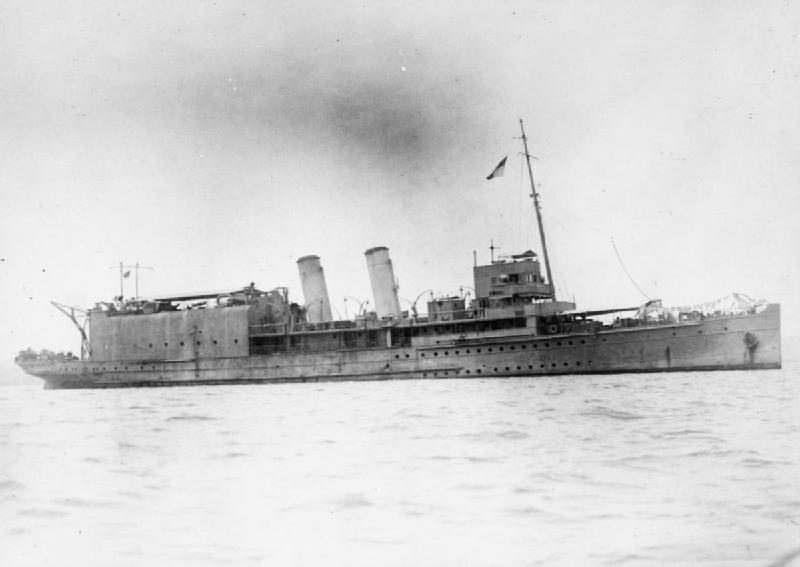
 Latest Facebook Entry -
Latest Facebook Entry -  X(Tweeter) Naval Encyclopedia's deck archive
X(Tweeter) Naval Encyclopedia's deck archive Instagram (@navalencyc)
Instagram (@navalencyc)





 French Navy
French Navy Royal Navy
Royal Navy Russian Navy
Russian Navy Armada Espanola
Armada Espanola Austrian Navy
Austrian Navy K.u.K. Kriegsmarine
K.u.K. Kriegsmarine Dansk Marine
Dansk Marine Nautiko Hellenon
Nautiko Hellenon Koninklije Marine 1870
Koninklije Marine 1870 Marinha do Brasil
Marinha do Brasil Osmanlı Donanması
Osmanlı Donanması Marina Do Peru
Marina Do Peru Marinha do Portugal
Marinha do Portugal Regia Marina 1870
Regia Marina 1870 Nihhon Kaigun 1870
Nihhon Kaigun 1870 Preußische Marine 1870
Preußische Marine 1870 Russkiy Flot 1870
Russkiy Flot 1870 Svenska marinen
Svenska marinen Søværnet
Søværnet Union Navy
Union Navy Confederate Navy
Confederate Navy Armada de Argentina
Armada de Argentina Imperial Chinese Navy
Imperial Chinese Navy Marinha do Portugal
Marinha do Portugal Mexico
Mexico Kaiserliche Marine
Kaiserliche Marine 1898 US Navy
1898 US Navy Sovietskiy Flot
Sovietskiy Flot Royal Canadian Navy
Royal Canadian Navy Royal Australian Navy
Royal Australian Navy RNZN Fleet
RNZN Fleet Chinese Navy 1937
Chinese Navy 1937 Kriegsmarine
Kriegsmarine Chilean Navy
Chilean Navy Danish Navy
Danish Navy Finnish Navy
Finnish Navy Hellenic Navy
Hellenic Navy Polish Navy
Polish Navy Romanian Navy
Romanian Navy Turkish Navy
Turkish Navy Royal Yugoslav Navy
Royal Yugoslav Navy Royal Thai Navy
Royal Thai Navy Minor Navies
Minor Navies Albania
Albania Austria
Austria Belgium
Belgium Columbia
Columbia Costa Rica
Costa Rica Cuba
Cuba Czechoslovakia
Czechoslovakia Dominican Republic
Dominican Republic Haiti
Haiti Hungary
Hungary Honduras
Honduras Estonia
Estonia Iceland
Iceland Eire
Eire Equador
Equador Iran
Iran Iraq
Iraq Latvia
Latvia Liberia
Liberia Lithuania
Lithuania Mandchukuo
Mandchukuo Morocco
Morocco Nicaragua
Nicaragua Persia
Persia San Salvador
San Salvador Sarawak
Sarawak Uruguay
Uruguay Venezuela
Venezuela Zanzibar
Zanzibar Warsaw Pact Navies
Warsaw Pact Navies Bulgaria
Bulgaria Hungary
Hungary

 Bundesmarine
Bundesmarine Dutch Navy
Dutch Navy Hellenic Navy
Hellenic Navy Marina Militare
Marina Militare Yugoslav Navy
Yugoslav Navy Chinese Navy
Chinese Navy Indian Navy
Indian Navy Indonesian Navy
Indonesian Navy JMSDF
JMSDF North Korean Navy
North Korean Navy Pakistani Navy
Pakistani Navy Philippines Navy
Philippines Navy ROKN
ROKN Rep. of Singapore Navy
Rep. of Singapore Navy Taiwanese Navy
Taiwanese Navy IDF Navy
IDF Navy Saudi Navy
Saudi Navy Royal New Zealand Navy
Royal New Zealand Navy Egyptian Navy
Egyptian Navy South African Navy
South African Navy






























 Ukrainian Navy
Ukrainian Navy dbodesign
dbodesign